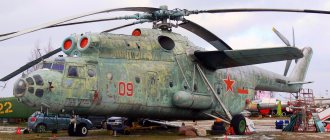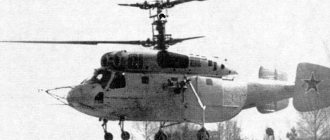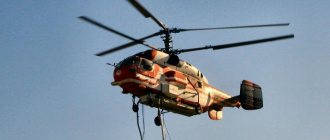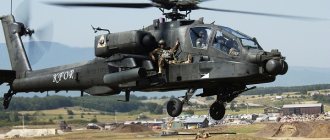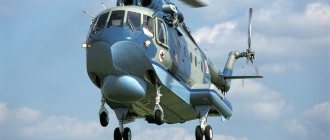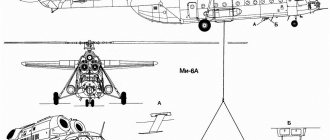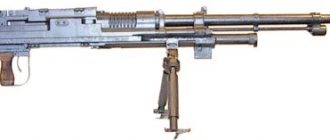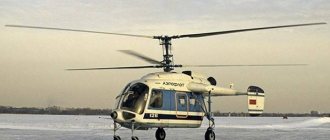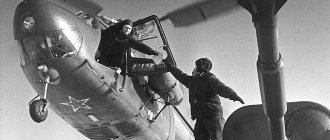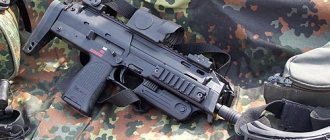Weapons and Armament > Helicopters > Multi-purpose > ANSAT multi-purpose helicopter
In 1994, a technical specification for the development of a light multi-purpose twin-engine helicopter was formed, and research and development work began on the creation of the ANSAT helicopter.
The helicopter is designed in accordance with domestic aviation regulations (AP-29) and taking into account the requirements of international standards (FAR-29).
The use of new design methods made it possible to save not only the design and manufacturing time of tooling, but also labor costs in other areas of production (assembly, preparation of documentation, maintenance), simplifying and optimizing the management of production processes. To ensure competitiveness in price and performance, the helicopter balances the use of modern and traditional technical solutions, structural materials and technologies. When creating the ANSAT helicopter, the concept of maximum manufacturability, minimum cost of mass production with maximum consideration of the needs of operators was adopted.
The light multi-purpose helicopter ANSAT with a payload of 1 - 1.3 tons, a maximum take-off weight of 3.3 tons and a passenger capacity of up to 9 people was created by the Design Bureau of Kazan Helicopter Plant JSC with the involvement of other organizations and enterprises traditionally involved in the development of aviation equipment. The high technical characteristics of the helicopter are ensured by two RK206S engines developed by the Canadian company Pratt & Whitney, certified in 1989. It is assumed that their price will be acceptable for domestic consumers and ANSAT will be cheaper than similar Western helicopters.
The ANSAT helicopter is created for use in the following variants: — transport, including for the transportation of cargo on an external sling; — passenger (up to 9 seats with compact seating); — administrative (5-6 passengers); — sanitary (two bedridden patients and two health workers); — emergency rescue (equipped with special equipment); — educational and training; - patrolman; - in other options upon request.
The Ansat helicopter has high performance characteristics. With a maximum take-off weight of 3300 kg, it is capable of transporting 1300 kg of payload in the transport version over a distance of up to 520 km at a speed of 240 km/h, spending only 3 hours 20 minutes. The flight range and duration depend on altitude, climatic conditions, helicopter speed and the weight of the cargo being transported. The helicopter has a service ceiling of 5500 - 6000 m, depending on the take-off weight, and a hover ceiling of 1800 - 2700 m. The range of action in the emergency rescue option, when the flight must take place at the maximum possible speed, reaches 190 - 210 km. The ferry range of an empty helicopter is 620 km. The helicopter can deliver a cargo weighing 1650 kg over a distance of up to 100 km. The use of additional fuel tanks will significantly increase the range and duration of the helicopter's flight.
CHARACTERISTIC
Characteristics
The technical parameters of the machine look very impressive, which has been repeatedly confirmed by experts and specialists at various exhibitions and aviation shows. Among the most significant are:
- The ability to lift 7 passengers into the air, while carrying up to 1.3 tons of weight;
- The engine power is 630 horsepower (for one), and during takeoff it is 463 kilovolts;
- The crew that pilots the device can consist of one or two people;
- The height of the helicopter is 3.56 meters;
- The chassis track is two and a half meters;
- The total length of the machine is more than 13.5 meters.
Ansat helicopter interior photo
The cargo compartment has impressive dimensions:
- length is 3.5 meters,
- width – 1.68 m,
- height – 1.3 m.
Such a device develops excellent speed - up to 285 kilometers per hour, and the cruising speed is 250 kilometers per hour. It rises at a speed of 21.5 meters per second.
Flight characteristics
The promising Ansat helicopter, photos of which were published by many media outlets, has excellent maneuverability. The relatively small size allows the helicopter to be used in urban transportation.
The maximum speed at which Ansat can fly is 275 km/h (cruising speed is 250 km/h). The device is capable of carrying up to 1,234 kg of cargo or up to seven (if necessary, up to ten) passengers.
The vehicle is equipped with on-board equipment, a flight navigation system, an information system, multifunctional indicators and a failure warning system. The helicopter can be controlled both manually and automatically. The helicopter is capable of flying in simple and difficult weather conditions.
Prospects
The Ansat helicopter, the photo of which fascinates with its visual lightness and swiftness of design, opens a new milestone in the domestic aircraft industry. Russian designers have proven that they can produce maneuverable, economical, easy-to-maintain helicopters for civilian use.
In May 2020, the first commercial orders were placed for Ansat. Three cars were reserved by air, two more planes were ordered by air. To establish direct contacts with helicopter operators, an official presentation of Ansat was held at Kazan Helicopter Plant in June 2015, in which more than 70 specialists from Russian airlines and special-purpose aviation took part. As part of regional cooperation, in 2020 KAZ handed over to the Ministry of Health of Tatarstan a device equipped with an ultra-modern medical module.
By 2020, the country's Air Force had acquired about 40 Ansat-U units, modified for use in the army. They are used for pilot training, demonstration flights, patrols and other purposes.
A large contract has been concluded with Chinese colleagues. In 2020, two Ansats equipped with a medical module will be delivered. By 2020, Russian Helicopters has committed to transfer another 6 units for civilian use. Of particular interest are VIP modifications for transporting important guests, company executives, and high-ranking officials.
Exploitation
Soon after the start of mass production, the Ansat turned out to be one of the most popular KVZ vehicles. By 2020, the Russian Air Force had received more than 40 Ansat-U training machines, and the medical version of the helicopter aroused particular interest among civilian buyers.
The first sanitary Ansats were received by the Tatar Ministry of Health. Then the new car was mastered in Kostroma. It was reported that thanks to the new medical Ansats, it was possible to increase the number of sorties. The Kazan “turntable” also became interested abroad – in 2020, a contract was signed for supplies to China.
Design
To manufacture the helicopter, an all-metal fuselage structure is used, the blades are made of fiberglass, and composite materials are used in non-power elements. The peculiarity of this aircraft is the balanced use in production of the latest developments in aircraft construction and traditional technical solutions.
The first prototype of the device was demonstrated at Farnborough in 1998. In 1999, an improved second model of the helicopter took off, after which its design was strengthened and received some changes. The third Ansat, manufactured in 2001, was noticeably different from previous copies. It has new aerodynamic fuselage shapes, made based on the results of tests. Its external forms became so perfect that they were copied by American manufacturers in the manufacture of the famous Bell-429.
History of creation
The creation of this helicopter began back in 1993, when the initiative group of the Kazan branch of the Mil helicopter plant conducted marketing research. Based on the data obtained, the engineers came to the conclusion that it was advisable to create a new device, which should be in a class between the Mi-2 and Mi-8.
The designers decided to create a machine with a carrying capacity of no more than 1,500 kg, which should have high technical qualities, meet consumer requirements and at the same time have a minimum cost. Initial attempts to negotiate the creation of such a helicopter with domestic manufacturers did not bring results, and foreign ones offered licensing under very strict conditions.
Therefore, a public design bureau was organized by Kazan Helicopter Plant OJSC, in which engineers who transferred from the Moscow Helicopter Plant began work on the project. Mil and teachers of the Aviation Institute. Subsequently, designers from other well-known design bureaus became interested in the developments of Kazan helicopter manufacturers. All work was carried out at the expense of KVZ, which was deducted from the plant’s profits. To bring the Ansant helicopter into mass production, the company manufactured more than 80 unique machines and special devices.
History of creation
The Ansat helicopter, whose characteristics are not inferior to foreign-made analogues, began to be designed at KAZ in 1996. A year later, the first prototype was assembled and took off on August 17, 1999. The Kazan Aviation Plant relied on this model, concentrating the main resources of the enterprise on its creation.
Work on its certification has been carried out for several years. In 2013, the International Aviation Committee entered the model into the aviation register with the right to transport cargo. In 2014, an addition was released that allowed the operation of the Russian Ansat helicopter for passenger transportation. In 2020, Medvedev tested the new device. According to Dmitry Anatolyevich, he liked the car. Having praised the new product, the head of the Russian government expressed his readiness to fly this helicopter in the future.
Customers
In the fall of 2020, the first Ansat with a medical module was transferred to the Ministry of Health of the Republic of Tatarstan.
In October 2020, the fleet (RVS) received a vehicle manufactured in the VIP version; which, however, will be used not only to transport passengers, but also as a training vehicle for the company's aviation training center.
As of May 2020, it is the largest civilian operator of Ansat helicopters and has 13 such helicopters and expects the delivery of 2 more machines in 2020.
In 2020, at the air show in Zhuhai, China, the Chinese company Wuhan Rand Aviation Technology Service Co. signed a contract for the supply of two medical-grade aircraft. Ltd.; The helicopters are planned to be delivered by the end of 2020. The Chinese company also issued an option that provides for the purchase of six more Ansats. The company is expected to receive them before 2019.
At the end of 2020 in China, as part of a demo tour, a firm contract was concluded for 20 Ansat helicopters, and “soft contracts” were also collected (Vietnam, Thailand, Cambodia and Malaysia) for another 30 helicopters of this model.
In 2020, the Russian Helicopters holding company (part of Rostec) will begin supplying Ansat helicopters with medical modules to China that meet international air ambulance standards and allow saving a person’s life during transportation.
Application[ | ]
Turboshaft engine VK-800V at MAKS 2013
The vehicle can be used to solve a wide range of tasks: cargo delivery, passenger transportation, search and rescue operations, patrolling, emergency medical care, administrative transportation, initial training.
A modification of the luxury helicopter (VIP) is offered for organizing the transportation of high-ranking passengers.
The helicopter is used in the Russian Aerospace Forces for training pilots (the Russian Armed Forces purchase Ansat helicopters in the training version, Ansat-U)[13], as well as in the Russian Ministry of Emergency Situations and the All-Russian Central Medical Center "Zashchita".
At the MAKS-2005 exhibition, a combat version of the helicopter was also presented - Ansat-2RTs[14]. There is no information about orders for it.
In May 2020, a helicopter modification with a medical module was certified, which meets all international air ambulance standards and allows saving a person’s life during transportation. According to the certificate, the design of the helicopter allows it to be quickly transformed into both a cargo and a passenger version with the ability to transport up to 7 people.[15]
Conditions of use
Currently, the production of several modifications of the Ansat helicopter has been launched. It is even produced for transporting dignitaries. VIP class devices have a more comfortable interior, with improved insulation from noise and vibration. Such vehicles carry up to 4 people. Training helicopters are equipped with an EMDS and a digital control system, with the help of which it is possible to perform various machine behaviors, even turning off the engine. This significantly increases the skill level of future pilots.
Ansat-2RC is a military model that uses 90% of the parts of the base vehicle. This allows you to create an attack helicopter from a civilian aircraft in 9 months.
Since 2006, serial production of Ansat helicopters began, and currently it is conquering more and more new markets. They are already flying in China, Laos, CIS countries, Iran, Korea and other parts of the world.
What is an Ansat light helicopter?
As Gazeta.Ru learned, the light multi-purpose Ansat helicopter created by the Kazan Helicopter Plant (KVZ) is of interest not only to domestic consumers, such as the Ministry of Health of Tatarstan, which ordered a medical version of the rotorcraft, and the Russian Ministry of Defense, which has already received more than 30 training training "Ansatov-U" for training cadets of helicopter schools. This helicopter has been presented by Rosoboronexport for several years at various international arms exhibitions and air shows. The KADEX 2020 exhibition in Astana was no exception, where Ansat participated in the flight program.
Kazan "Ansat"
is a light twin-engine gas turbine multi-purpose helicopter with seven to nine seats, designed using a single-rotor design with a tail rotor.
“Ten countries have shown substantive interest in this helicopter. Among them are the CIS regions, Latin America, Africa and the countries of the Asia-Pacific region. In particular, these are Kazakhstan and Chile. Negotiations are underway at various stages, but it is too early to talk about concluding contracts,” special exporters told Gazeta.Ru.
"Foolproof car"
The Russian Ministry of Defense has signed a contract for the supply of 30 new Yak-130 combat training aircraft by the end of 2020.
“Gazeta.Ru” tells... → As KVZ General Director Vadim Ligai reported in February after the visit of the Iranian delegation to the plant and their statement of intention to purchase Ansat in a medical version, in any version.”
Today there are three versions of Ansat: passenger, medical and “truck”.
The helicopter can carry 1.3 thousand kg of payload in the cabin and has the ability to quickly transform the cabin layout. As Alexey Garipov, chief designer of the Kazan Helicopter Plant, explained to Gazeta.Ru, the Ansat has a fairly large cargo compartment volume, which allows it to transport a large volume of cargo, including bulky ones. In addition, the helicopter can accommodate passengers quite comfortably - the seats are located “even more comfortably than in a standard economy class airliner.”
“The machine was made taking into account the existing experience of the Mi-8, it has classic standard technologies that are known to our Russian operator - domestic oils and materials, it’s reliable,” said Garipov. — The avionics in it are quite traditional; today there are no too newfangled elements, but there are reliable electromechanics that allow the machine to be operated at low and high temperatures. "Ansat is a universal workhorse that can be operated day and night in temperature conditions from -50º to +50º."
Why does the Ministry of Defense need Predators?
The Russian Ministry of Defense has ordered about ten Raptor fast patrol boats.
Where do the Russian military use aquatic Predators... → While the helicopter does not have a certificate for –50º, there is a limitation to –35º. At the same time, the designer notes, there are still plans to bring it to the “Arctic” level: “This year we plan to conduct tests for plus in the summer and minus in the winter. If we talk about the Arctic, there are nuances. If we talk about short-term -50º, then we plan to do this. From our point of view, any modifications to the design will not be needed or they will be insignificant,” the source said.
In terms of components, manufacturers adhere to the policy of using domestic materials, although for now the helicopter has a Canadian engine, which creates certain restrictions on its purchase, for example, by government agencies.
But Russian industrialists are already working on creating a replacement for it as part of the import substitution program - the project was led by St. Petersburg Klimov, and literally in May, during the Helirussia 2020 exhibition, the Rostec holding company Technodinamika announced the start of work on a family of propulsion engines for light helicopters , in particular to replace the Pratt & Whitney engines on the Ansats. “The project is designed for four years, during which 12 engines will be created (five for flight testing). TD-701 will be certified according to international standards,” the holding says in a statement.
Representatives explain that one of the key advantages of the new engine will be the use of a unified gas generator, which will reduce development and development costs. “The cost of the serial engine will be reduced by 15% compared to analogues. A single hardware part of the automatic control system (ACS) will be developed for the family of engines,” Technodinamika reported.
Aviation Explorer analyst Vladimir Karnozov notes that Russia has been trying to make an engine for this helicopter for fifteen years, “but everything is in the same place.”
The Ministry of Defense purchased additional super-maneuverability
The Russian Ministry of Defense, after the successful use of Su-30SM multirole fighters in Syria, signed a contract for the supply of more than 30 more of these... →
“There is a VK-800 engine, which Klimov is trying to make, but so far there has not been much progress there. As for Technodinamika, this is some kind of amazing event for the expert community, because this holding has never produced engines before, and suddenly they take on this business. If they succeed, they will have to erect a monument to them,” Karnozov told Gazeta.Ru.
He also noted that the Ukrainian Motor Sich and ZMKB Progress in Zaporozhye have been trying to make a similar engine for a long time; they have the AI-450, but “they are still struggling with it.” The expert still relies on Klimov’s developments, since the plant has a long history - it made not only helicopter engines, but also good tank engines, as well as marine ones. But the plant needs restoration.
Let us note that the Russian engine for Ansat is very much awaited by the Ministry of Defense. In the summer of 2020, Deputy Minister of Defense for Armaments Yuri Borisov instructed KVZ to prepare proposals for this helicopter, in particular for the VIP version of the Ansat for short-distance flights by the department’s leadership, for which it is inappropriate to use the existing “salons” of heavy Mi-8 helicopters. But until the import substitution program is completed, the military cannot take this car. The exception is the educational version for cadets of Aerospace Forces schools. As the developers note,
"Ansat" has a hingeless semi-rigid bushing, which gives it large control moments - it is quite maneuverable, it can be used to demonstrate piloting with serious rolls and pitches. At the same time, pilots can easily transfer from Ansat to Mi-8, for which this light helicopter prepares them.
“When transferring to the Mi-8 from Ansat, the pilot has the same horizons and arrows. There, of course, there is an on-board computerized control system that shows how much fuel, engine parameters, supply systems - more modern. But as for classic flight instruments, they are standard. There is no super-automation on Ansat-U. It turned out to be a normal “desk” that forgives, but does not allow you to relax,” says Garipov.
“Ansat-U is a training helicopter for the Ministry of Defense, which, firstly, has a wheeled landing gear, and other versions have a ski-mounted one, and also
It has a fly-by-wire flight control system, which is cool for a helicopter.
This machine, in the amount of about 36 units, was transferred to the Ministry of Defense, with which cadets learn to fly helicopters. I don’t know if the Ministry of Defense still has a need for them; there are currently enough of them for training cadets, but they can still purchase them,” notes analyst Karnozov.
Mistral leaves for Cairo
The first helicopter carrier Mistral built for the Russian Navy in France will be handed over to Egypt on June 2.
As the DCNS company told Gazeta.Ru, the ship... → For the civilian market, according to him, Ansat with a fly-by-wire control system has not yet been able to be certified, so helicopters with an older hydromechanical control system are being operated. At the same time, Karnozov notes a large number of competitors for this helicopter in the civil transportation market. Our Ansat is considered light, but in the world it is considered medium, because there is something even lighter, and significantly, it has a take-off weight of 3.6 tons, and there is a weight of less than 1 ton. There are many manufacturers of medium helicopters in the world that hold this market, and there is very strong competition - Airbus Helicopters, Bell, Augusta Westland - they are very firmly in there,” the interlocutor explained, adding that you can try to win back the market by offering a low price.
As KVZ designer Garipov explained to Gazeta.Ru, the helicopter has great capabilities for retrofitting it with various kinds of devices, including removable baskets, which are often required by commercial operators. For the conditions of the North, an additional electric stove is installed on the VIP version of Ansat, and the presence of a kerosene heater, like on the Mi-8, is also being discussed.
At the HeliRussia exhibition, Deputy Head of Russian Helicopters Alexander Shibitov announced plans to create a new shipborne helicopter. Today, Russia operates the anti-submarine Ka-27 and creates the Ka-52K Katran, designed for the Mistral helicopter carriers not supplied by France. Gazeta.Ru inquired about the possibility of upgrading Ansat to a ship version.
“Theoretically, yes, this is possible, but in practice we need such a task, the presence of a customer. Technically, the system for folding the blades does not present any difficult task; sailors may need some additional devices. Here, in this situation, additional corrosion protection will also be necessary for such small helicopters - this is salt, that is, special coating and maintenance procedures are necessary. We need to look at the tests,” said designer Garipov.
“Although, in my opinion, it is still better to use helicopters with a coaxial propeller system on ships,” he added.
An important point is the machine's security system. Since Ansat is a light helicopter, it does not have the option of shooting off the blades, but the pilot’s cabin is equipped with emergency release doors. The civilian version is equipped with energy-absorbing seats to ensure the crew can survive a hard landing. And at the request of the Aerospace Forces, they are equipped with parachutes.
History of creation
The size and functional appearance of the Ansat helicopter were determined as a result of marketing research conducted by Russian airlines to determine the requirements for helicopters of this class.
The first prototype of the helicopter was assembled in May 1997. The first flight took place in 1999. In 2011, the certification process for the civilian version of the helicopter began. In August 2013, a type certificate was received from the Aviation Register of the Interstate Aviation Committee.
The machines are produced by the Kazan Helicopter Plant (the plant plans to assemble 16 helicopters in 2020).
There are plans to replace the helicopter engines with domestic VK-800V produced by Klimov OJSC.
October 28, 2020 – The Russian Helicopters holding company plans to supply about 40 Ansat helicopters, as the company’s Deputy General Director Alexander Shcherbinin told reporters.
In June 2020, the first Ansat helicopter in Russia equipped with a resuscitation module arrived in Volgograd.
In May 2020, at the HeliRussia exhibition, Ansat received approval for the main change to expand the operating temperature range. Thus, at the moment, the Ansat helicopter is certified for use in the temperature range from -45 to +50 degrees Celsius.
Notes
- Magazine "Helicopter" No. 3, 2009, p. 4
- https://kazanhelicopter.ru/ansat/
- The new helicopter of the Russian Air Force is as economical as a car (inaccessible link - history
). Retrieved December 24, 2012. Archived January 3, 2014. - Lenta.ru: Science and technology: The Russian Air Force will receive 30 Ansat light helicopters
- The civil "Ansat" from the State Medical University received an AR IAC certificate » Mechanical Engineering Resource. Mechanical engineering: mechanical engineering news, articles. Catalog: machine-building plant and enterprises
- Air Force cadets will receive new Ansat helicopters in 2014 | RIA News
- We are import substituting in full force: the VK-800V engine will replace the American PW-207K
- https://warfiles.ru/show-23871-legkiy-boevoy-vertolet-ansat-2rc-rossiya.html
- The new helicopter of the Russian Air Force is as economical as a car: Science and technology: Lenta.ru
- https://www.aex.ru/news/2016/10/28/161606/
- https://rostec.ru/news/4519280
- 06/09/2017 Volgograd was the first in Russia to receive the Ansat air ambulance helicopter
- Specifications. Ansat. Kazan Helicopters. Kazan Helicopter Plant.
- The Military Balance 2020, p.199
- The Kazan Helicopter Plant will deliver 16 Ansat helicopters to customers by the end of the year. AEX
(17/05/17).
Engines
Initially, the Ansat helicopter was equipped with a pair of PW207K model turboshaft engines manufactured by Pratt Whitney Canada. They are equipped with a two-channel electronic digital control system (FADEC). In the event of an emergency shutdown of one of them, the helicopter is able to continue taking off.
The power of each engine at takeoff mode reaches 630 hp. With. The cruising speed of the device reaches 250 km/h. The vehicle, equipped with main tanks, is capable of flying at a distance of up to 510 km.
In the future, the Ansat helicopter will be transferred (in whole or in part) to domestically produced power plants. At the moment, VK-800V engines, which are designed by Klimov OJSC, are being tested. These engines will become the basis for all types of light Russian aircraft. It is also planned to be installed in a turboprop version on drones and light aircraft. Technical documentation for VK-800V has been fully developed and approved, and a preliminary design has been created. The power unit is successfully tested.
China accelerated due to coronavirus
Typically, certification of helicopters in foreign countries lasts at least 3-4 years, and China carried it out quite quickly by European standards, sources close to KVZ note.
“Certification is not done instantly,” explains Realnoe Vremya’s interlocutor, a representative of the aviation industry. — For example, in Canada, with a favorable attitude, the term is 3 years. These are their deadlines - we do not determine them. In China, we hoped it would be faster, but there, too, everything seemed to start well and there were no questions. But then the Chinese had their own problems, and the process dragged on. But, in principle, 2 years is a good time, it’s fast.
— The flight characteristics of Ansat were demonstrated a year and a half ago. There were no special complaints about the technology. But then legal problems appeared. We hoped that it would be a year and a half earlier, because the team of pilots and specialists had no questions. But then on the spot, in China, they encountered legal issues.
The expert believes that the acceleration of validation was influenced by the coronavirus epidemic, which taught a clear lesson about how important it is for sanitary services to always be mobile and fly to hotspots of infection. Photo by Maxim Platonov. Nevertheless, the entire set of documents was ready then, all procedures were strictly followed and there were no concessions
In general, the timing of certification is determined by two factors - the volume of work and the workload of certification centers, the expert explained:
Nevertheless, the entire set of documents was ready then, all procedures were strictly followed and there were no concessions. In general, the timing of certification is determined by two factors - the volume of work and the workload of certification centers, the expert explained:
— If there is an interested company that is planning to or has already signed contracts with you, then you are put a little higher in the queue. And if you go as usual, then it can last 4 years or even 5 years. In China, Ansat became the first Russian machine to pass certification quickly enough.
According to him, if the contract is signed, then the production of helicopters should already be launched, which means that delivery will occur very soon. “And if the beginning of obtaining a certificate means the fact of signing a contract, then this will take a sufficient period of time - up to a year,” he believes.
However, the Federal Air Transport Agency explains the fast deadlines by a simplified procedure for approving a standard design. “In June 2020 in the Kremlin in the presence of the President of the Russian Federation V.V. Putin and Chinese President Xi Jinping held a ceremony for the exchange of “Procedures for the implementation” of the Russian-Chinese intergovernmental agreement on flight safety BASA, signed between Rosaviatsiya and SAAS, which allow creating conditions for a simplified procedure for approving the standard design of Russian aircraft exported to the PRC,” the press reported. - service of the Federal Air Transport Agency.
“It’s difficult for me to judge the reasons for the possible acceleration of consideration of this issue in China,” says Oleg Panteleev, executive director of the AviaPort industry agency. “We can only say that KVZ has production capabilities that significantly exceed the demand for Ansat helicopters contracted by the Chinese side.” The labor intensity of manufacturing helicopters is lower than that of the Mi-8, the current workload of the KVZ is moderate, the assembly of the Ansat is well established. The situation is simple - take it and do it. Louise Ignatieva
IndustryMechanical engineering Tatarstan
Main nodes
The third model of the helicopter was equipped with more powerful PW-207K engines, which do not reduce their performance in emergency situations. In this model, some units were replaced, a new tail rotor was installed, and the chassis structure was made of metal. This copy was certified and was approved for mass production. The result was a machine with perfect flight characteristics.
The electric remote control system installed on the Ansat increases its maneuverability and facilitates control. Such a system was used for the first time; previously it was installed only on MiG and Su aircraft. Hingeless blade mounts were also developed for the first time. For the manufacture of components and assemblies, light alloys with shot peening are used. If one engine is turned off, it can safely continue to fly on one.
Device
The helicopter was built on the basis of a single-rotor design with a tail rotor, which is used in all modern designs of such machines. It features increased safety, which is presented in two variations:
- Innovative electric remote flight control system;
- Hydromechanical control system.
The machine is equipped with two gas turbine engines with a power of 630 horsepower, produced by the Canadian company Pratt and Whitney. They can be controlled using a specially created electronic digital system, which allows you to control the device if one of the engines fails.
Ansat helicopter in the sky photo
The flight and navigation systems, as well as on-board equipment, include:
- Indicators with many functions;
- A system that warns of engine failures;
- On-board information system.
The fuselage is all-metal, which perfectly harmonizes with composite materials and fiberglass blades. The operation of the main rotor is associated with a hingeless hub, which provides a high level of control.
Description
The Ansat helicopter is manufactured at the helicopter plant in Kazan, which is part of the Russian Helicopters united holding. The twin-engine vehicle, built according to the classic single-rotor design with a tail rotor, has a number of advantages over similar models. The aircraft received an all-metal body, composite non-strength elements and fiberglass blades.
The passenger version of the helicopter has the most spacious cabin in its class. Moreover, the interior can be quickly transformed. This capability is important if it is necessary to quickly re-equip a helicopter to perform special missions.
In addition to cargo/passenger transportation, Ansat can be used for surveillance, search and rescue, and firefighting operations. The latest version, which received a certificate addition in May 2020, is equipped with a sanitary cabin.
Specifications
“Ansat” is the first helicopter in the world, which, having such a weight category, can accommodate 10 passengers in its cabin. It can transport loads weighing up to 1300 kg over 600 km at a speed of 240 km/h. The flight range is influenced by such factors as speed, climatic conditions, cargo weight, altitude. Additionally, additional fuel tanks can be installed on it, which significantly increases the flight duration.
- Length - 13,543
- Height - 3,560
- Crew - 1 person
- Number of passengers - 9 people
- Lifting load mass - 1300 kg
- Maximum take-off weight - 3300 kg
- Engine power - 2x630 hp
- Maximum speed - 285 km/h
- Cruising speed - 250 km/h
- Practical range - 635
- Practical/Strategic ceiling - 5700/3300 m
- Climb speed - 21.5 m/sec
Helicopter "Ansat": technical characteristics
Initially, the helicopter was created with a fly-by-wire control system (KSU-A), which made it the first device in the world with such a system. Later it was decided to create a version with a traditional hydromechanical control system. As KVZ General Director Vadim Ligai previously explained, the reason was the tightening of requirements for the certification of civilian vehicles with KSU-A. However, replacing the control system did not affect either the weight of the vehicle or its characteristics:
- Total length – 13.54 m.
- Height with screws – 3.5 m.
- Width – 2.6 m.
- Crew – 1 or 2 pilots.
- Payload – up to 7 (10) passengers, or 1.3 tons of cargo.
The Ansat light helicopter has an all-metal fuselage. Non-power elements are made using composite materials. The propeller blades are made of fiberglass. The main rotor hub is made using a hingeless design, which allows you to achieve a high level of controllability and save on operating costs.
Modifications
The spacious Ansat cargo compartment allows you to obtain options for various purposes through simple conversion.
First of all, the helicopter is designed as a cargo or passenger helicopter. The version with a luxury cabin can be used for administrative transportation. The rescue and ambulance helicopters were certified. This modification can not only be used for training purposes - such a feature as the ability to quickly retrofit is retained.
In 2005, at the air show, the original combat modification “Ansat 2RC” was presented, outwardly similar to the American “Cobra” and different from the basic version, just as the “Cobra” was different from the “Iroquois”. The Ansat assault aircraft received a two-seater tandem-type cabin, armed with a 12.7 mm Kord machine gun and units of unguided missiles. In addition, the production of a “simplified” modification, equipped with a traditional hydromechanical control system instead of a fly-by-wire control system, was mastered.
